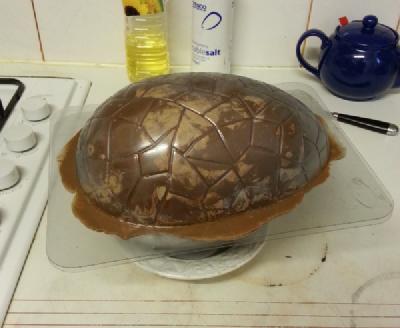Giant Creme Egg
Tea club started with some Whittard’s Cherry Blossom tea, followed by some Fine Cut Lemongrass tea. The lemongrass tea left a lot of stuff at the bottom of the thing, perhaps because it is so fine that it escaped the filter thingy. I really need to improve my terminology.
Every single track of Mario Kart on the N64 was then played, well, except for Rainbow Road - that course is just too tedious.
In a more exciting turn of events, we travelled far across the urban wilderness of Portsmouth to humble abode of Waitrose. A number of items were bought:
The plan was this: make a giant Cadbury Creme egg.
Below follows the process for making one:
Ingredients:
- 2.2kg icing sugar
- 1.85kg Cadbury dairy milk chocolate
- 1kg golden syrup
- 350g butter
- 5 tablespoons of vanilla essence
- Yellow food colouring (though you should use orange)
Tools:
- Two 25cm x 17cm egg moulds
- Mixing bowl large enough to place over your head
- Pastry brush
Instructions:
- Mix together the golden syrup and butter. Gradually add the icing sugar in, a little bit at a time. Once mixed thoroughly, you should have a bowl weighing over 3kg and tasting delicious. (Takes about 2 hours)
Place mixture in the fridge, then perform steps 3 to 7.
Melt the chocolate over boiling water, starting with just about 200g.
Put a little bit of oil in each egg mould, and use the pastry brush to spread it around.
Using the pastry brush, paint a layer of melted chocolate onto the egg moulds. Paint slightly beyond the edge of the mould. Don’t make the layers too thick.
Put the moulds in the fridge for 10 to 15 minutes (such that the chocolate is no longer runny). Then repeat step 5: keep repeating this process until all chocolate has been used up. This amounted to 14 layers of chocolate, over the course of nearly 4 hours.
Leave in the fridge overnight.
- With a sharp knife, cut the excess chocolate off that protrudes above the top of the mould. This should leave you with a flat chocolate plateau about half an inch wide all the way around.
Take the mixture out the fridge, and separate about 1/3rd of it into a separate bowl, and add lots of colouring to it. We used yellow food colouring, but that was a bit of an oversight - creme eggs are actually orange in the middle.
With the egg halves still in their moulds, gradually add in the uncoloured mixture. Spread it around with a knife, making sure to spread the mixture up above the height of the mould - this is because the mixture is slightly elastic, and always returns to a smaller size than initially spread into. Leave a large dent in the middle of each egg.
Fill the middle dents with the coloured mixture. Pray that you have enough to fill up to the top. Then leave in the fridge overnight (again).
Melt some more chocolate, and spread a thick layer all around the rim of one egg half. With both halves still in their moulds, place them adjacent such that they are symmetrical.
Each egg half weighs approximately 2.5kg. Enlist the help of a fellow human being, and have them slowly lift up one egg half while you lift up the other, rotating both halves upwards until they stick together forming an egg shape, oddly enough.
Carefully place the whole egg in a bowl for stability, and press around the mould to ensure the chocolate forms a tight seal all the way around. Place in the fridge for 1 hour.
Remove the egg from the fridge, and placing it horizontally in a bowl again, lift the top mould off. Cut all the excess chocolate off. Flip the egg over and remove the other mould. Use paper towels when touching the egg to avoid it melting.
Pose the egg for some saucy shots.
- Wonder what on earth you will now do with this monstrosity. Take into account the following facts:
- It weighs 5kg;
- It contains approximately 4000% of your GDA of sugar;
- It is equivalent to about 125 Cadbury creme eggs.
EDIT 2018-02-13:
Bonus pictures §
Upon converting this blog from Wordpress to Markdown, I found some previously unseen photos.
A day or so after finishing the egg, it split from top to bottom!
What was the solution to this catastrophe? More chocolate!
And for the finishing touches, the careful strokes of an artist paint on the creme egg logo.
And finally, several months later in April 2013, the egg is finally cracked open:
















